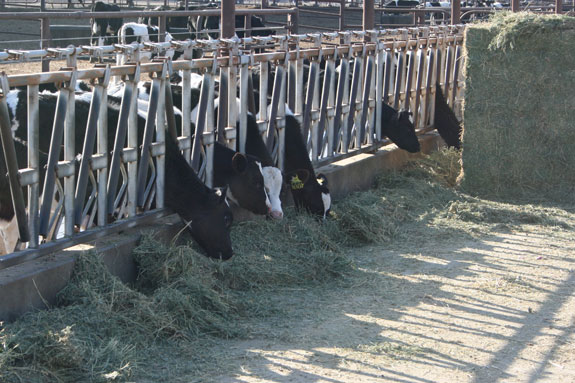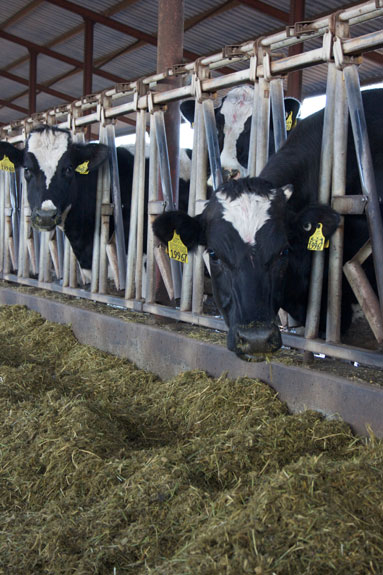Summary: This timeless Feed and Nutrition article details four steps for developing a sound nutritional program: 1. Testing forages to determine their nutrient content 2. Balancing rations for heifers, dry cows and milking cows 3. Implementing the balanced ration 4. Evaluating how well the feeding program has worked and implement changes to improve the program, if necessary. Because this article was so popular, we asked Donna Amaral-Phillips a follow-up question: Q: Which of these four steps slips up the most producers? A: Over my career, I have seen farmers, their employees and/or the nutritional consultant slip up on any or all of these critical steps. However, I must say the most common error I observe is related to implementation of step 4 – evaluating the cost-effectiveness of the feeding program.
Often times, dairy farmers get busy with other management aspects of the operation, i.e. getting cows bred, and once they balance a ration for a particular crop year, they forget to go back and evaluate if changes are needed in the ration actually consumed by the cows.
The key questions to ask are:
1. Are my cows (or group of cows) eating this ration and not excessively sorting their feed?
2. Are my cows or group of cows milking well on this ration? (The milk records need to be reviewed)
3. Has the quality of forages changed since they were originally analyzed?
4. Do I need to look at alternate feeds since I will be out of a forage or commodity, have prices changed, or will the make-up of the group of cows be changing?
Finally, the most important component is communicating and discussing the results of this review with not only your nutritionist but also your employees or family members who actually feed and help manage the dairy cows or heifers.
—Donna Amaral-Phillips, Extension Dairy Nutritionist, University of Kentucky
[Click here or on the image above right to see the full list of the Top 25 articles of 2011. Click here to see the list from 2010.]
ARTICLE

The overall goal of a sound, profitable dairy feeding program is to convert homegrown forages into milk.
With our heifer-rearing programs, we are looking for efficient growth of heifers so that they can become profitable milk-producing units.
Grain mixes are formulated to complement these forages and provide the nutrients which are not supplied by the forages themselves.
Several steps are involved in developing a sound and practical nutritional program for a dairy business. These steps include:
Oftentimes, steps 3 and 4 are not associated with the development of a profitable feeding program, but in reality, they are the most important steps in this process.
Step 1: Test forages to determine their nutrient content
Testing forages to accurately determine their dry matter and nutrient content is an essential starting point for developing a sound and profitable nutrition program.
The nutrient content of forages varies with stage of maturity when harvested, as well as between cuttings and crop years.
For example, if your corn silage tested 6.6 percent crude protein instead of the average of 8.2 percent and cows consumed 50 lbs of corn silage, your cows would have been underfed protein if you had not tested the silage but just assumed that the protein was 8.2 percent.
This deficiency in protein is the amount of crude protein needed to produce 9 lbs of milk. The same concept holds that when energy is underfed, cows will not milk to their potential and/or they may not easily rebreed.
On the other side of the coin, if your silage was higher in protein, a lower-protein grain mix could be fed, which would lower feed costs. Also, if it was higher in energy, less grain would need to be fed.
With feed costs representing 40 to 60 percent of the cost of producing milk, knowing the correct nutrient content is very important from an economic perspective.
All forages which will be fed to not only the milking cows but also heifers and dry cows, need to be tested. All lots of hay should be sampled using a hay probe from 10 or more bales of hay.
Sampling one or two bales is not an accurate way to sample hay. (A “lot” of hay is defined as those bales which were harvested from the same field and cutting.) Your local feed company or extension agent can help you get your forages tested.
Testing forages and balancing rations for heifers and dry cows is critical in order to get heifers to grow efficiently and prevent dry cows from losing or gaining too much weight.
Heifers not supplied with adequate amounts of protein are smaller in stature, whereas heifers deficient in energy are lightweight for their age. Both of these nutrient shortages may reduce milk production after calving and/or have higher rearing costs.
Dry cows should be turned dry in good body condition and they should not lose or gain body condition during the dry period.
Dry cows which calve at higher or lower-than-ideal body condition scores may produce 1000 to 1500 lbs less milk in the next lactation. Rations not properly balanced for energy can result in dry cows losing weight or gaining too much weight.
Forages need to be allocated based on the quality of the forage as it relates to the cattle’s nutrient needs. Early lactation cows and baby calves need to be fed the highest-quality hay or forages available.
Both of these groups are unable to consume enough feed to meet their nutrient needs. Thus, they need the highest-quality forage available to receive as many nutrients as possible out of each bite of feed.
Heifers over five months old and dry cows can utilize forages of lower quality. Here, the key word is lower quality, not poor quality. Adequate amounts of grain need to be fed to meet their energy and protein needs.
Hay or silages of poor quality will not allow heifers to grow in stature and weight at the correct rate. Dry cows, fed poor-quality forages or not fed the appropriate amount of grain, lose weight and these dry cows will not milk as well during the next lactation.
Feeding excessive amounts of corn silage to heifers and dry cows can result in over-conditioned animals.
back to top
Step 2: Work with your nutritionist to balance rations for your heifers, dry cows and milking cows
Once your forages are tested, these results should be used to formulate a ration which fits your feeding system as well as supply the cows with the nutrients they need.
Oftentimes, I have seen farmers spend quite a bit of time getting their forages sampled and then not have a ration balanced for their cattle. Rations deficient in any particular nutrient can decrease milk production, growth rates of heifers, reproduction efficiency and/or cause health problems.
On the other hand, rations which contain excess nutrients decrease profits and may result in other health problems.
Work with your nutritionist to get a ration you feel comfortable mixing and feeding and one your cows will eat. Rations should be balanced to utilize the forages on hand.
Just as importantly, these rations should be balanced to reflect the amount of these forages on hand and a particular feeding system. Make sure you understand the amount of each feedstuff which should be fed.
Also, it is very important you understand why different feedstuffs were added to the ration. For example, with finely chopped corn silage, it may be critical that your cows consume a set amount (5 lbs to 10 lbs) of above-average quality hay, or else they will have health problems later or may even die.
Rations need to be reformulated when the type of forage or the quality of the forage changes. Changes in the type and quality of forages can affect the amount of nutrients cows receive.
These small changes could decrease milk production, the ability of a cow to regain body condition or weight during the second half of her lactation, or decrease the growth rate of heifers.
On the flip side of the coin, we do not want to overfeed and ineffectively use our financial resources. Thus, rations need to be re-evaluated frequently to make sure heifers and cows are receiving the nutrients needed.
Many different combinations of forage and concentrates will meet the nutrient needs of cows. The goal is to find a cost-efficient combination which you, the farmer, are comfortable feeding and which is balanced to meet the cows’ (or heifers’) nutrient needs.

Step 3: Putting the feeding program in place, implementing a sound feeding program
Testing forages and balancing a ration to use available forages are the starting point in developing a sound feeding and management program for the milking herd.
Farmers should work closely with their nutritionist in designing a feeding program so the nutrient needs of a dairy cow are met and, at the same time, feed costs are minimized.
Once a feeding program has been designed, implementing the feeding program becomes the next critical step, and this step is under the control of the farmer and/or the feeder.
Once a ration is balanced on paper, it is important to make changes in your feeding program to reflect the changes in the balanced ration. These changes could include a change in the grain mixture fed to the cows and the amount of each forage being fed.
This change is easily made in most feeding systems. Often, the amount of grain mixture fed is increased or decreased based on the quality of forages being fed. This change is easily overlooked and can have a substantial impact on cash flow.
The amount of grain consumed by your cows reflects the amount of energy they receive, in addition to the energy found in their forages.
Not feeding the appropriate amount of grain or forages can decrease production, especially in early lactation cows. Then, reconfirm that you are providing the amount of grains and forages listed on the printed ration.
If you are using a TMR mixer, check that the scales are working properly to ensure the correct amount of each feedstuff is in the ration.
Getting cows to consume the combination of forages and grains is the key to getting cows to milk to their potential. The more feed an early lactation cow eats, the more milk she can produce.
Feed intake is governed by the size of the cow, how much milk she is producing and how fresh she is. Higher-producing cows need to eat more feed than lower-producing cows.
If the feedbunk is empty before the next feeding, cows should be fed more feed even if that additional amount is not listed on the balanced ration. When feeding a TMR, the amount of additional feed should include more of all feedstuffs in the diet, not just more forage.
In other words, feed like there are additional cows in the group. Enough feedbunk or hay ring space must be provided so that all cows, including timid cows and first-calf heifers, are able to eat fresh feed.
Feedbunks have to be cleaned out routinely. Changes in forages should be made gradually to prevent health problems.
Dairy cows should be managed to encourage them to eat many meals a day. Studies at Michigan State suggested that cows ate ten or more times a day when feed was in front of them at all times.
When cows space their feed consumption out over the day, they may spend more time lying down ruminating, hence the rumen microbes or bugs are more productive. Thus, the cow potentially can produce more milk and she may be healthier.
Often, it is stated that three different rations are fed to dairy cows. The first ration is balanced by the nutritionist, the second reflects the ration fed by the farmer, and the last, and most important, is the combination of forages and grains consumed by the cow herself. Taking time to make sure your cows are consuming a balanced ration will pay financial dividends.
Step 4: Evaluating the cost-effectiveness of a dairy’s feeding program
When we look at evaluating a feeding program for dairy cows, we need to look at different aspects.
Are the cows getting enough nutrients to support their milk production? Cows which are underfed protein and/or energy produce less milk.
When protein is added to the diet, milk production responds within a week. Cows which do not receive enough energy oftentimes do not peak in production, are thinner than expected for a particular stage of lactation, and may not breed back as quickly.
The amount of body condition cows carry at a particular stage of lactation indicates how well a nutrition and management program is working. It is important to evaluate the amount of condition cows carry at various stages of their lactation.
Just looking at the amount of condition cows are carrying without knowing their calving date and breeding history reveals very little about how well the nutrition and management program is working.
Minerals and vitamins need to be fed in adequate amounts for efficient milk production. Deficiencies can affect reproduction and the ability of the cow to fight off infections, such as mastitis.
To prevent these costly problems, the proper amounts of minerals and vitamins must be supplied and actually consumed by all dairy cattle, including the milking herd, dry cows and heifers.
We know that dairy cows are great sorters of their feed. When we evaluate rations, we need to minimize the ability of cows to sort their feed.
Long (muzzle-width) particle-size forages are needed to stimulate cud chewing or rumination. When we walk through a group of cows, we want to observe at least 60 percent of the cows chewing their cud when they are resting.
When reviewing a feeding program, we want to make sure this program is cost-effective. To accomplish this, review the costs associated with feeding your cows. Are there ways we can reduce costs while at the same time maintaining or increasing milk production per cow?
• Maximize the use of forages. High-quality forage is the cheapest source of nutrients for milk cows or heifers. A grain mix should be fed to complement the forages. Testing forages and balancing rations are the key to making your forages a very economical part of your feeding program.
• When was the last time an analysis was taken of your silage and hay? If your samples were taken a couple of months ago, it may be a good time to have another sample taken. Most feed companies run forage analysis at no charge.
• Does the grain mixture reflect the use of economical commodities for your area?
• For heifers and dry cows, are you feeding the amount and composition of a grain mixture which reflects their needs and the forages you are feeding?
• When purchasing a commercial grain mix, look at more than the price of the grain mix. Several of the larger feed companies sell four to eight different grain mixes with the same crude protein content.
One of the differences in these grain mixes is the amount of energy cows can receive from them. The cheapest 18 percent crude protein grain mix may or may not be the best buy.
• Evaluate the effectiveness and cost-to-benefit ratio of the various additives to your cows’ grain mix. Some examples of common feed additives include yeast, organic trace minerals, sodium bicarbonate (or soda) or protected fat sources.
If you are using these products, have they produced a beneficial response? What is the cost to you to have these included in the grain mix?
As with any business, it is important to review the cost and effectiveness of various management programs. The key to any successful business is making the most profit while containing costs and maximizing productivity. PD
—Excerpts from University of Kentucky Extension

-
Dr. Donna Amaral-Phillips
- Extension Dairy Nutritionist
- University of Kentucky
- Email Dr. Donna Amaral-Phillips






